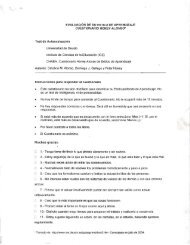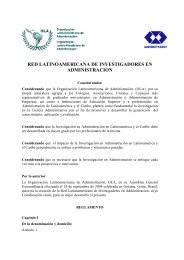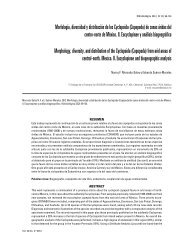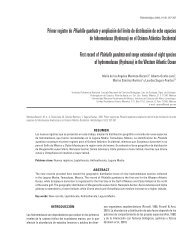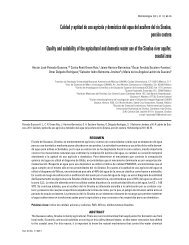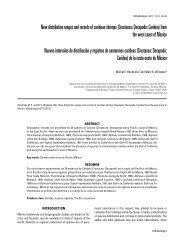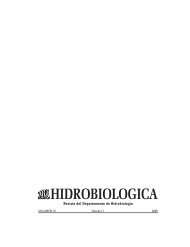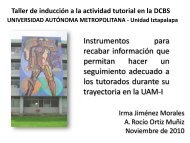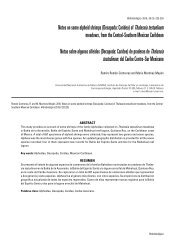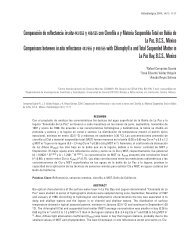Codium decorticatum
Codium decorticatum
Codium decorticatum
- No tags were found...
Create successful ePaper yourself
Turn your PDF publications into a flip-book with our unique Google optimized e-Paper software.
Hidrobiológica 2003, 13 (1): 1-8Fine structure of the utricles and gametogenesis of <strong>Codium</strong> <strong>decorticatum</strong> (Caulerpales, Chlorophyta)Ultraestructura de los utrículos y gametogénesis en <strong>Codium</strong> <strong>decorticatum</strong> (Caulerpales, Chlorophyta)Alicia B. Miravalles,Patricia I. Leonardiand Eduardo J. CáceresLaboratorio de Ficología y Micología, Departamento de Biología, Bioquímica y Farmacia, Universidad Nacional del Sur, 8000 Bahía Blanca, Argentina.Miravalles, A. B., P. I. Leonardi and E. J. Cáceres, 2003. Fine structure of the utricles and gametogenesis of <strong>Codium</strong> <strong>decorticatum</strong> (Caulerpales, Chlorophyta). Hidrobiológica13 (1): 1-8.ABSTRACT<strong>Codium</strong> <strong>decorticatum</strong> utricles exhibited a large central vacuole surrounded by a thin parietal layer of cytoplasm.Nuclei and other organelles were placed in the outermost portion of the cytoplasm whereas chloroplastsprotruded into the vacuole. The utricle cell wall was formed by a single stratum covered by a rugose cuticle.Only gametangia producing a single type of gametes were observed. Progametangia consisted of an apicalvacuolate portion and a basal portion with partitioned cytoplasm. The clear apical portion of immaturegametangia revealed abundant endoplasmic reticulum, dictyosomes and electron translucent vacuoles. Most ofthe gametangium volume was occupied by spherical nuclei and small chloroplasts. Gametes were delimitatedby the activity of electron translucent vesicles. Mature gametes were pear-shaped with a prominent papillaoccupied by the basal apparatus. An anterior nucleus was anteriorly flanked by a large mitochondrion.Spherical non-flagellate cells with a discrete cover were also observed in the gametangia. The gametes of<strong>Codium</strong> <strong>decorticatum</strong> resemble the male gametes of other siphonous green algae, in the flagellar apparatusmorphology, in the appearance of the capping plate and the structure and location of the terminal caps, and inthe presence of one large mitochondrion. We can assert that the Atlantic Argentinian populations produce onlymale gametes. Therefore, agamic germination of male gametes would be the only asexual reproductionmechanism of the Argentinian populations. Further studies are necessary to confirm the hypothesis that thesepopulations reproduce asexually by germination of only one type of cell, male gametes that in this case may befunctionally considered zoospores.Key words: <strong>Codium</strong> <strong>decorticatum</strong>, gametogenesis, siphonous green algae, ultrastructure, utricle.RESUMENLos utrículos de <strong>Codium</strong> <strong>decorticatum</strong> presentaron una gran vacuola central rodeada por una delgada capa decitoplasma parietal. Núcleos y otras organelas se localizaron en la porción más externa del citoplasma parietal,mientras que los cloroplastos hicieron protrusión en la vacuola. La pared del utrículo presentó un único estratocubierto por una cutícula aserrada. Sólo se observaron gametangios produciendo un solo tipo de gametas. Losprogametangios presentaron una porción apical vacuolada y una basal con el citoplasma particionado. Laporción apical clara del gametangio inmaduro reveló abundante retículo endoplásmico, dictiosomas y vacuolaselectrónicamente translúcidas. La mayor parte del gametangio estaba ocupado por núcleos esféricos ypequeños cloroplastos. Las gametas maduras piriformes presentaron una prominente papila. Un núcleo anteriorestaba flanqueado anteriormente por una gran mitocondria. En los gametangios se observaron célulasesféricas aflageladas con una discreta cubierta. En general, las gametas de <strong>Codium</strong> <strong>decorticatum</strong> se asemejan
2Miravalles, A. B., et al.a las gametas masculinas de otras algas verdes sifonales, como lo indican la morfología del aparato flagelar("capping plate" y "terminal caps") y la presencia de una gran mitocondria. De acuerdo a estas observaciones,concluimos que las poblaciones atlánticas argentinas producen sólo gametas masculinas. Por lo tanto, lagerminación agámica de gametas masculinas sería el único mecanismo de reproducción asexual de laspoblaciones argentinas. Posteriores estudios son necesarios para confirmar la hipótesis de que estaspoblaciones se reproducen asexualmente por germinación de gametas masculinas que en este caso puedenser consideradas zoósporas.Palabras claves: <strong>Codium</strong> <strong>decorticatum</strong>, gametogénesis, algas verdes sifonales, ultraestructura, utrículo.INTRODUCTIONThe genus <strong>Codium</strong> Stackhouse is characterized by thallicomposed by interwoven coenocytic filaments which form aloose and colorless medulla and an utricle palisade cortex(Borden and Stein, 1969b). Gametangia are borne laterally onutricle protuberances (Silva, 1960). The genus has been describedas having a pronounced anisogamy (Borden and Stein,1969b); however, Feldmann (1956), Dangeard and Parriaud(1956), Churchill and Moeller (1972), Rico and Pérez (1993) haveindicated the presence of only one type of gametes in <strong>Codium</strong>fragile, described as female gametes which germinateparthenogenetically.The available information on <strong>Codium</strong> species is fragmentary.Reproduction and differentiation at the optical microscopelevel in <strong>Codium</strong> fragile (Suringar) Hariot have beenstudied (Arasaki et al., 1956; Borden and Stein, 1969a,b; Churchilland Moeller,1972; Ramus,1972; Prince, 1988; Park andSohn, 1992; Rico and Pérez, 1993). Schussnig (1950) studiedgametogenesis at the optical microscope level in <strong>Codium</strong> <strong>decorticatum</strong>(Woodward) Howe and also there are caryologicalstudies of this species (Schussnig, 1950; Kapraun and Martin,1987, Kapraun et al., 1988). The only ultrastructural studiesdone in the genus consist of brief observations on chloroplastsand nuclei (Hori and Ueda, 1967; Roth and Friedmann,1980).The aim of this research is to study at the optical and ultrastructurallevel the utricle morphology and the gametogenesisprocess in field-collected thalli of <strong>Codium</strong> <strong>decorticatum</strong>populations growing along the Atlantic Argentinian coast.MATERIALS AND METHODSThalli of <strong>Codium</strong> <strong>decorticatum</strong> bearing gametangia indifferent stages of development were collected in PuertoMadryn, Province of Chubut (42º 46' S, 65º 03' W), in Las Grutas,Province of Río Negro (40º 44' S, 64º 56' W) and in BahíaSan Blas, Province of Buenos Aires (40º 34’ S, 62º 14’ W).Light microscopy studies were carried out with a LeitzSM Lux microscope and a Carl Zeiss Axiolab microscope withanoptral phase-contrast. For transmission electron microscopystudies, utricles and gametangia in different stages ofdevelopment were fixed in 2% glutaraldehyde in 0.1M cacodylatebuffer, postfixed in 1% OsO 4 , dehydrated in an acetoneseries, and embedded in Spurr’s low viscosity resin(Spurr, 1969) by the flat embedding method (Reymond and Pickett-Heaps,1983). Sections were cut with a diamond knifeand stained with uranyl acetate and lead citrate. Sectionswere observed with a JEOL 100 CX-II electron microscope atthe Centro Regional de Investigaciones Básicas y Aplicadasde Bahía Blanca (CRIBABB), Bahía Blanca, Argentina.Utricle structureRESULTS<strong>Codium</strong> <strong>decorticatum</strong> utricles were cylindrical, 1 mm longand somewhat dilated at the apex, measuring 250 µm wide (Fig.1). In transverse sections two zones were recognized: a largecentral vacuole and a circumvacuolar thin parietal layer of cytoplasm(Fig. 2). The vacuolar contents were homogeneous.Nuclei were adjacent to the cell wall in the outermostportion of the cytoplasm (Fig. 2). In interphase, they were polymorphicwith the main axis parallel to the utricle cell wall (Fig.2). They were 4 - 6 µm long and 1.5 - 3 µm wide. They had scarceheterochromatin distributed in the nucleoplasm and one ortwo prominent nucleoli. Dictyosomes, endoplasmic reticulumand mitochondria were also located in this region (Fig. 3). Vesiclescontaining either electron translucent contents or fuzzymaterial were adjacent to the plasmalemma (Fig 3).The chloroplasts placed in the innermost portion of theparietal cytoplasm protruded into the vacuole; they were fusiformand were oriented predominantly perpendicular to theutricle cell wall (Fig. 2). Chloroplasts with various featureswere observed in the same utricle: some of them presentedstroma mainly occupied by thylakoids, small starch granulesHidrobiológica
Fine structure of <strong>Codium</strong> <strong>decorticatum</strong>3the wall (Fig. 8). Gametangia were disposed mainly in lines ofutricles situated in the inner side of dichotomies (Figs 9, 10).GametogenesisProgametangia were ovoid and pale green at the opticalmicroscope level (Fig. 11). Their fine structure showed an apicalvacuolate portion (Fig. 12) and a basal portion with the cytoplasmpartitioned by a system of vesicles forming afenestrated reticulum (Figs 12, 13). The cytoplasm containeddictyosomes with their cis face in association with rough endoplasmicreticulum (Fig. 14), recently divided nuclei (Fig. 15)and scarce small ovoid chloroplasts mainly occupied bystarch granules and reduced thylakoids (Fig. 12). Fuzzy materialwas observed between the plasmalemma and the cellwall (Fig. 16).Immature gametangia had a refringent apical portion andbright green homogeneous contents at optical level (Fig. 17).Figures 1-8. <strong>Codium</strong> <strong>decorticatum</strong> vegetative structure. 1. Light micrographof utricle with a mature gametangium. X500. 2-8. TEMmicrographs. 2. Transverse section of utricle. X2000. 3. Detail of aportion of cell wall and cytoplasm. X14000. 4-6. Different chloroplastfeatures. X14000. 4. Transverse section through a chloroplastwith the stroma mainly occupied by thylakoids. 5. Longitudinal sectionthrough a chloroplast with reduced thylakoids and one largestarch granule. 6. Longitudinal section through a plastid almostcompletely occupied by a starch granule. 7. Detail of the clearbands crossing the medial wall portion. X6700. 8. Detail of twostrataportion of wall. X14000.and lipid globules (Fig. 4); and others presented reduced thylakoids,lipid globules and one or more oval starch granules(Fig. 5); other plastids were almost completely occupied by alarge starch granule (Fig. 6).The utricle cell wall was formed by a single 1.5 - 3.5 µmwide stratum (Fig. 3). In the medial wall portion, there wereclear bands surrounded by an electron dense sector (Fig. 7)that crossed the whole wall transversally at regular intervals.A thin rugose cuticle covered the utricle cell wall (Figs 3, 7, 8).Only one type of gametangium producing one type of gameteswas observed. The gametangia were located singly orin pairs on the side of each utricle on conspicuous protuberancesand they were separated from the utricle by a septum(Fig.1). Near the union between the gametangium and the utricle,there was a second fibrillar 0.15 - 0.28 µm wide stratum inFigures 9-16. <strong>Codium</strong> <strong>decorticatum</strong> gametogenesis. 9-11. Light micrographs.9. General branch view with gametangia disposed in aline (arrowheads). X175. 10. Transverse section of a branch withgametangia (arrowheads). X280. 11-16. Progametangia. 11. Progametangium.X850. 12-16. TEM micrographs. 12. Longitudinal sectionof progametangium with the vacuolated apical portion. X2000.13. Detail of the basal cytoplasm. X8000. 14. Detail of dictyosomesassociated with reticulum endoplasmic. X2700. 15. Recently dividednuclei. X10000. 16. Detail of portion of cytoplasm showing thefuzzy material between plasmalemma and cell wall (arrow).X10000.Vol. 13 No. 1 • 2003
4Miravalles, A. B., et al.In the next stage the translucent contents increased inthe apical zone (Fig. 22). Portions of cytoplasm with one nucleus,many chloroplasts and the rest of organelleswere delimited by electron translucentvesicles, initiating the separation ofthe developing gametes (Fig. 23). Concentricmembranes and mucilage were foundbetween gametes (Fig. 24).Figures 17-24. <strong>Codium</strong> <strong>decorticatum</strong> gametogenesis. Immature gametangia.17. Light micrograph. X850. 18-21. TEM micrographs.18. Gametangium apex. X2700. 19. Detail of a portion of gametangium.X27000. 20. Detail of small chloroplasts. X4000. 21. Detail ofcentripetal growth of wall separating the gametangium from theutricle. X6700. 22. Light micrograph of a gametangium showingthe apical mucilage. X850. 23-24. TEM micrographs. 23. Detail ofaligned electron translucent vesicles delimiting the future gametes.X14000. 24. Detail of the concentric membranes and mucilagebetween the gametes (arrowheads). X5000.They were twice as long as progametangia. The fine structureof the clear apical portion (Fig. 18) revealed abundant bothsmooth and rough endoplasmic reticulum, dictyosomes withvesicles and electron translucent vacuoles (Fig. 19). Nucleiwere spherical and exhibited scattered heterochromatin (Fig.18). Most of the gametangium volume was occupied by numeroussmall chloroplasts, originating by division (Fig. 20). Thegametangium wall was thinner than the utricle wall - 0.6 - 0.7µm wide - (Fig. 18). At this developmental stage a ring of wallstarted to form centripetally by vesicle congregation (Fig. 21)separating the gametangium from the utricle.Mature gametangia were dark greenand the gametes were individualized at opticallevel (Fig. 25). Gametes about to bedischarged were pear-shaped (Fig. 26) andmeasured 12 - 16 µm long and 8 - 11 µm wide.The basal apparatus occupied a prominentpapilla and the flagella emergedbackwards (Fig. 27). A continuous electrondense, non-striated capping plate with anenlarged central region connected the basalbodies (Fig. 27). Terminal caps consistingof two subunits disposed orthogonallyto each other were associated with eachbasal body; one subunit was closely appresedto the anterior surface of the basalbody while the other covered its proximalend (Fig. 27). A proximal sheath with constantthickness subtended the proximal endof each basal body (Fig. 27). A spherical nucleusoccupied the anterior portion of the cell (Figs 26, 28) andwas flanked anteriorly by a large inverted V-shaped mitochondrion(observed in serial sections, Fig. 28) whose arms,in transverse section, had biconcave shape (Fig. 29). Severalstacks of five to ten sacs of rough endoplasmic reticulum wereassociated with the nuclear envelope (Fig. 30). Electrondense vesicles of 0.18 - 0.37 µm diam were observed near thenucleus and next to the plasmalemma (Fig. 27). Numerous chloroplastswere found in both the median and the posteriorportions of the gametes (Fig. 26).In the apical tip of mature gametangia, a prominent mucilagecap was formed, then it retracted from the apex forminga concavity first (Fig. 31 and inset) and eventually theexit canal when the gametes were released.Spherical non-flagellate cells with a discrete cover (Fig.32) were also observed in the same gametangium.Abreviations used in figures: C: chloroplast; Cu: cuticle;CP: capping plate; CW: cell wall; D: dictyosome; ER: endoplasmicreticulum; F: flagellum; M: mitochondrion; Mu: mucilage;N: nucleus; PS: proximal sheath; S: starch; V: vesicle; Va: vacuole.Hidrobiológica
Fine structure of <strong>Codium</strong> <strong>decorticatum</strong>5the pattern present in other siphonousalgae, such as Bryopsis hypnoides Lamouroux,Caulerpa prolifera (Forsskål)Lamouroux, Udotea petiolata (Turra)Börgesen, Derbesia tenuissima (DeNotaris) Crouan, Halimeda tuna (Ell. etSol.) Lamouroux, Penicillus capitatusLamark (Burr and West, 1970; Sabnis,1969, Dawes and Barilotti, 1969; MarianiColombo, 1978; Wheeler and Page,1974; Palandri, 1972; Turner and Friedmann,1974).Figures 25-32. <strong>Codium</strong> <strong>decorticatum</strong> gametogenesis. Mature gametangiaand male gametes. 25. Light micrograph. X650. 26-32. TEMmicrographs. 26. Mature gamete with an anterior nucleus andmany chloroplasts. X5000. 27. Detail of an apical portion of a gameteshowing the prominent papilla, the capping plate, the terminalcap (arrowhead) and the proximal sheath. X27000. 28. Longitudinalsection through the anterior portion of a gamete showing thelarge mitochondrion adjacent to the nucleus. X27000. 29. Transversesection through nucleus and mitochondrion. X10000. 30. Roughendoplasmic reticulum associated with nuclear envelope. X16000.31. Detail of mucilage at gametangium apex. Note it is partially retracted.X2700. Inset: light micrograph. X1400. 32. Spherical aflagellatecell with discrete covering (arrowheads). X27000.Utricle structureDISCUSSIONThis is the first comprehensive ultrastructural study carriedout in the genus <strong>Codium</strong>. In general, the ultrastructuralorganization of C. <strong>decorticatum</strong> utricles does not differ fromHowever, there are some aspectsworth mentioning with respect to theultrastructure of the members of theorder Caulerpales. The cell wall in <strong>Codium</strong><strong>decorticatum</strong> has a homogeneousaspect, such as that in Penicillus capitatusand Udotea petiolata (Turner andFriedmann, 1974; Mariani Colombo,1978); while in Bryopsis hypnoides,Caulerpa sertularioides (Gmelin) Howeand Derbesia tenuissima it has fibrillaraspect (Burr and West, 1970; Mishra,1969; Wheeler and Page, 1974). Thenumber and disposition of the wallstrata also vary: whereas in Penicilluscapitatus the wall is stratified, in Udoteapetiolata it has a single stratum, asin the <strong>Codium</strong> <strong>decorticatum</strong> utricle forthe most part. Nevertheless, in the latter, a thin additionalstratum is observed near the union of the gametangium andthe utricle. Something similar occurs in Bryopsis hypnoides,which also has a single stratum over most of the thallus and alongitudinal wall with layers adjacent to the plug (Burr andWest, 1970). The cell wall of Derbesia tenuissima has a thickinner layer composed of several strata and an outer electrondense layer (Wheeler and Page, 1974).A cuticle is generally present in Caulerpales (Roth andFriedmann, 1987). In Bryopsis hypnoides (Burr and West,1970) and Udotea petiolata (Mariani Colombo, 1978) it is rugose,as the one described here in C. <strong>decorticatum</strong>; on the contrary,in Derbesia tenuissima the cuticle is smooth (Wheelerand Page, 1974).In Bryopsis hypnoides two rather distinct layers can bedistinguished in the mature parietal cytoplasm: an outer layeror ectoplasm next to the cell wall which contains most of theorganelles and an inner layer or endoplasm where the chloroplastsare located (Burr and West, 1970). Even though weVol. 13 No. 1 • 2003
6found a similar disposition of the organelles in <strong>Codium</strong> <strong>decorticatum</strong>,the ecto and endoplasm differentiation was not soobvious.Chloroplasts with numerous thylakoids and scarcestarch granules, similar to those described by Hori and Ueda(1967) in <strong>Codium</strong> fragile and C. repens, were observed in C.<strong>decorticatum</strong>. Moreover, we also observed in the same utriclechloroplasts with reduced thylakoids and one or more ovalstarch granules and plastids almost completely occupied witha large starch granule. Although this variation can not be considereda heteroplasty as occurrs in Caulerpa, Dichotomosiphon,Avrainvillea, Chlorodesmis, Halimeda and Udotea (Horiand Ueda, 1967; Borowitzka, 1976; Roth and Friedmann, 1987),the great variation observed in the number of thylakoids andthe amount of starch in different plastids in the same utriclein <strong>Codium</strong> <strong>decorticatum</strong> is noteworthy.GametogenesisIn 1950, Schussnig studied gametogenesis of C. <strong>decorticatum</strong>at optical level. The present report is the first ultrastructuralstudy of the gametogenesis in the genus. Thedevelopment of gametangia has been studied ultrastructurallyonly in two species of Caulerpales: Derbesia tenuissimaand Bryopsis hypnoides (Wheeler and Page, 1974; Burr andWest, 1970), whereas in Caulerpa racemosa there are studiesonly at the optical microscope level (Enomoto and Ohba,1987).The disposition of gametangia in lines of utricles situatedin the inner side of dichotomies in C. <strong>decorticatum</strong> is describedfor the first time in the genus. In other species of<strong>Codium</strong> the gametangia are disposed mainly at random.Gamete formation in C. <strong>decorticatum</strong> occurred in the cytoplasmof the basal portion of the gametangium; in Bryopsishypnoides, the differentiation of gametes begins in the cytoplasmremaining in the periphery of the gametangium (Burrand West, 1970).In C. <strong>decorticatum</strong> nuclear division took place in the progametangiafollowed by chloroplast division. On the contrary,in Bryopsis hypnoides, the first indication of gamete formationis the simultaneous multiplication of chloroplasts and nuclei(Burr and West, 1970).Miravalles, A. B., et al.In C. <strong>decorticatum</strong> the portions of protoplasm that willgive rise to the gametes are initially delimitated by sphericalelectron translucent aligned vesicles. In Bryopsis hypnoidescleavage takes place also through vesicles but they are large,flattened and aligned around the nucleus (Burr and West,1970). In the case of Derbesia tenuissima and D. marina protoplasmcleavage occurs by proliferation of vacuoles betweenthe organelles (Wheeler and Page, 1974).Gamete discharge in C. <strong>decorticatum</strong> took place throughan operculum. The gametes were released in a stream of aslimy substance as happens in other species of the genus,such as C. fragile, C. tomentosum, C. elongatum and C. bursa(Borden and Stein, 1969b). In other Caulerpales, such as Derbesia,Bryopsis and Caulerpa, gamete release takes place inthe area under a papilla after the dissolution of the wall (Burrand West, 1970; Wheeler and Page, 1974; Enomoto and Ohba,1987).In general, the flagellar apparatus of the gametes of <strong>Codium</strong><strong>decorticatum</strong> resembles that of male gametes of Derbesiatenuissima (Roberts et al., 1981), in the morphology of thecapping plate, the structure and location of the terminal capsand the presence of proximal sheaths. The last feature is neitherdescribed by the authors in D. tenuissima nor in Pseudobryopsissp. (Roberts et al., 1982), although electron denseproximal sheaths subtending the proximal end of the basalbodies were observed in their figures 12 and 8. Terminal capsformed by two orthogonally disposed subunits are also presentin male gametes of Bryopsis maxima and Pseudobryopsissp. (Hori, 1977; Roberts et al., 1982). The last two generaalso possess a capping plate similar to that of C. <strong>decorticatum</strong>;however, in those cases each capping plate half is distallyattached by a fibrous connective (Roberts et al., 1982)instead of by an electron dense material.Just as in all male gametes studied in the Caulerpales(Burr and West, 1970; Gori, 1979; Hori, 1977; Roberts et al.,1981, 1982), C. <strong>decorticatum</strong> gametes presented an anteriorlarge mitochondrion and no eyespot. On the contrary, the femalegametes of the Caulerpales studied, possess severalsmall mitochondria and generally an eyespot (Hori, 1977; Robertset al., 1982).Schussnig (1950) observed male and female gametangiain C. <strong>decorticatum</strong> growing in Mediterranean Sea (NaplesGulf); Kapraun and Martin (1987) presumed also sexual reproductionby anisogametes in the same species in the NorthAtlantic coast (North Carolina); however, we found only onetype of gametangium in the South Atlantic coast. Even thoughSchussnig (1950) does not mention gamete measurements,the nucleus size of South Atlantic coast gametes agrees withthat described by Schussnig for C. <strong>decorticatum</strong> male gametes.Considering also that the fine structure features of C. <strong>decorticatum</strong>gametes agree with those of male gametes ofother siphonous green algae, we can assert that the AtlanticArgentinian populations of C. <strong>decorticatum</strong> produce only onetype of gametes, and that these belong to the male sex.Hidrobiológica
Fine structure of <strong>Codium</strong> <strong>decorticatum</strong>The rounding of the cells inside the gametangium concomitantwith the loss of the flagella and a synthesis of a discretecovering by the cells, observed in our study, suggestsan intragametangial germination. Therefore, agamic germinationof male gametes would be the only asexual reproductionmechanism of the Argentinian populations. Parthenogeneticalgermination of microgametes has been predicted for C.<strong>decorticatum</strong> by Schussnig (1950) who inferred their zoosporicpotentiality, from an analysis of the gametogenesis. Thegametes of C. fragile populations of the Atlantic coast havebeen described as female gametes capable of parthenogeneticdevelopment by Feldmann (1956), Dangeard and Parriaud(1956), Dangeard (1958), Churchill and Moeller (1972), Ricoand Pérez (1993). Further studies are necessary to confirm thehypothesis that <strong>Codium</strong> <strong>decorticatum</strong> populations reproduceasexually by germination of male gametes, that in this casemay be functionally considered zoospores.ACKNOWLEDGEMENTSThis investigation was supported by grants from ConsejoNacional de Investigaciones Científicas y Técnicas de laRepública Argentina, Grants PIP 0949/98 to EJC and by theUniversidad Nacional del Sur, Grants PGI SGCyT 2119/00 toEJC. P.I.L. is a research member of the CONICET. E.J.C. is a researchmember of the Comisión de Investigaciones Científicasde la Provincia de Buenos Aires (CIC), Argentina. Wethank Dr Max Chacana for providing valuable comments onthe manuscript.REFERENCESARASAKI, S., H. TOKUDA and K. FUJIYAMA. 1956. The reproduction andmorphogeny in <strong>Codium</strong> fragile. Botanical Magazine Tokyo 69: 39-44.BORDEN, C. and J. STEIN. 1969a. Mitosis and mitotic activity in <strong>Codium</strong>fragile (Suringar) Hariot: Chlorophyceae. Phycologia 8: 149-156.BORDEN, C. and J. STEIN. 1969b. Reproduction and early development in<strong>Codium</strong> fragile (Suringar) Hariot: Chlorophyceae. Phycologia 8:91-99.BOROWITZKA, M. A. 1976. Some unusual features of the ultrastructure ofthe chloroplasts of the green algal order Caulerpales and their development.Protoplasma 89: 129- 147.BURR, F. A. and J. A. WEST. 1970. Light and electron microscope observationson the vegetative and reproductive structures of Bryopsishypnoides. Phycologia 9: 17-37.CHURCHILL, A. C. and H. W. MOELLER. 1972. Seasonal patterns of reproductionin New York populations of <strong>Codium</strong> fragile (Sur.) Hariotsubsp. tomentosoides (van Goor) Silva. Journal of Phycology 8:147-152.DANGEARD, P. 1958. Recherches sur quelques <strong>Codium</strong>, leur reproductionet leur parthénogénèse. Botaniste 42: 65-88.DANGEARD, P. and H. PARRIAUD. 1956. Sur quelques cas de développementapogamique chez deux espèces de <strong>Codium</strong> de la region duSud-Ouest. Compte Rendu Academie des Sciences de Paris 243:1981-1983.DAWES, C. J. and D. C. BARILOTTI. 1969. Cytoplasmic organization andrhythmic streaming in growing blades of Caulerpa prolifera. AmericanJournal of Botany 56: 8-15.ENOMOTO, S. and H. OHBA. 1987. Culture studies on Caulerpa (Caulerpales,Chlorophyceae). I. Reproduction and development of C. racemosavar. laetevirens. The Japanese Journal of Phycology 35:167-177FELDMANN, M. J. 1956. Sur la parthénogénèse du <strong>Codium</strong> fragile (Sur.)Hariot dans la Méditerranée. Compte Rendu Academie des Sciencesde Paris 243: 305-307.HORI, T. 1977. Electron microscope observations on the flagellar apparatusof Bryopsis maxima (Chlorophyceae). Journal of Phycology13: 238-243.HORI, T. and R. UEDA. 1967. Electron microscope studies on the finestructure of plastids in siphonous green algae with special referenceto their phylogenetic relationships. Science Reports, TokyoKyoiku Daigaku. 12: 225-244.KAPRAUN, D. F., M. G. GARGIULO and G. TRIPODI. 1988. Nuclear DNA andkaryotype variation in species of <strong>Codium</strong> (Codiales, Chlorophyta)from the North Atlantic. Phycologia 27: 273-282.KAPRAUN, D. F. and D. J. MARTIN. 1987. Karyological studies of threespecies of <strong>Codium</strong> (Codiales, Chlorophyta) from coastal North Carolina.Phycologia 26: 228-234.MARIANI COLOMBO, P. 1978. An ultrastructural study of thallus organizationin Udotea petiolata. Phycologia 17: 227-235.MISHRA, A. K. 1969. Fine structure of the growing point of the coenocyticalga, Caulerpa sertularioides. Canadian Journal of Botany 47:1599-1603.PALANDRI, M. 1972. Aspetti ultrastrutturali dell invecchiamento dei filamenticenocitici in Halimeda tuna (Ell. et Sol.) Lamour. Caryologia25: 211-235.PARK, C. S. and C. H. SOHN. 1992. Effects of light and temperature onmorphogenesis of <strong>Codium</strong> fragile (Suringar) Hariot in laboratoryculture. The Korean Journal of Phycology 7: 213-223.7Vol. 13 No. 1 • 2003
8Miravalles, A. B., et al.PRINCE, J. 1988. Sexual reproduction in <strong>Codium</strong> fragile ssp. tomentosoides(Chlorophyceae) from the Northeast coast of North America.Journal of Phycology 24: 112-114.RAMUS, J. 1972. Differentiation of the green alga <strong>Codium</strong> fragile. AmericanJournal of Botany 59: 478-482.REYMOND, O. L. and J. D. PICKETT-HEAPS. 1983. A routine flat embeddingmethod for electron microscopy of microorganisms allowing selectionand precisely orientated sectioning of single cells by light microscopy.Journal of Microscopy 130: 79-84.RICO, A. and L. PÉREZ. 1993. <strong>Codium</strong> fragile var. novae-zelandiae (Chlorophyta,Caulerpales) en Punta Borja, Chubut, Argentina: aspectosreproductivos. Naturalia patagónica 1: 1-7.ROBERTS, K. R., H. J. SLUIMAN, K. D. STEWART and K. R. MATTOX. 1981.Comparative cytology and taxonomy of the Ulvaphyceae. III. Theflagellar apparatuses of the anisogametes of Derbesia tenuissima(Chlorophyta). Journal of Phycology 17: 330-340.ROBERTS, K. R., K. D. STEWART and K. R. MATTOX. 1982. Structure of theanisogametes of the green siphon Pseudobryopsis sp. (Chlorophyta).Journal of Phycology 18: 498-508.ROTH, W. C. and E. I. FRIEDMANN. 1980. Taxonomic significance of nucleus-microbodyassociations, segregated nucleoli and other nuclearfeatures in siphonous green algae. Journal of Phycology 16:449-464.ROTH, W. C. and E. I. FRIEDMANN. 1987. Ultrastructure of the siphonousgreen algae Avrainvillea and Cladocephalus. Phycologia 26: 70-81.SABNIS, D. D. 1969. Observations on the ultrastructure of the coenocyticmarine alga Caulerpa prolifera, with particular reference to someunusual cytoplasmic components. Phycologia 7: 24-42.SCHUSSNIG, B. 1950. Die Gametogenese von <strong>Codium</strong> <strong>decorticatum</strong>(Woodw.) Howe. Svensk Botanisk Tidskrift 44: 55-71.SILVA, P. C. 1960. <strong>Codium</strong> (Chlorophyta) in the Tropical Western Atlantic.Nova Hedwigia 1: 497-536.SPURR, A. R. 1969. A low-viscosity epoxy embedding medium for electronmicroscopy. Journal of Ultrastructural Research 26: 31-43.TURNER, J. B. and E. I. FRIEDMANN. 1974. Fine structure of capitular filamentsin the coenocytic green alga Penicillus. Journal of Phycology10: 125-134.WHEELER, A. E. and J. Z. PAGE. 1974. The ultrastructure of Derbesia tenuissima(De Notaris) Crouan. I. Organization of the gametophyteprotoplast, gametangium and gametangial pore. Journal of Phycology10: 336-352.Recibido: 28 de junio de 2002.Aceptado: 29 de noviembre de 2002.



